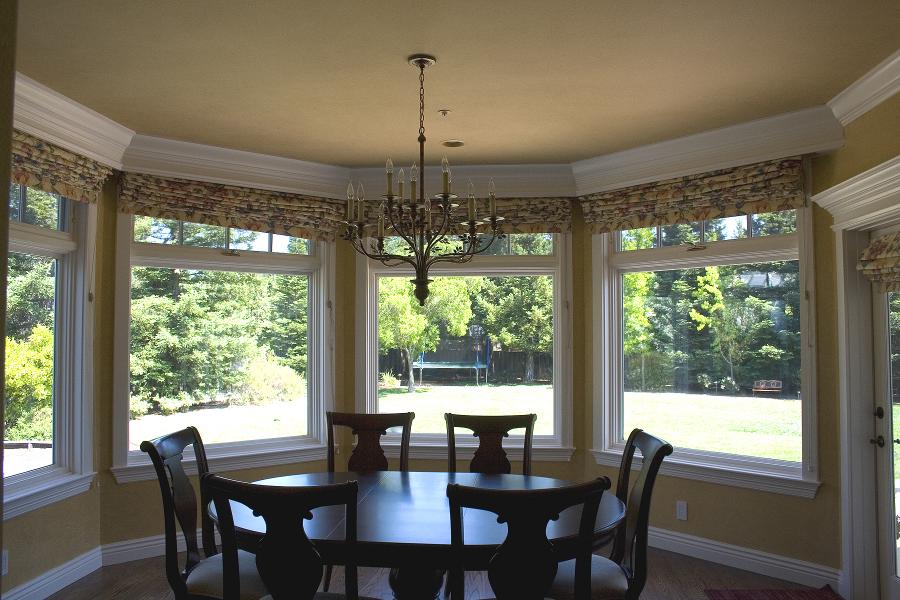
While it’s an often-overlooked aspect of the painting process, ceiling color plays a crucial role in a room’s aesthetics. Photo: Pro-Staff Painting & Faux Finishing (2014)
When planning to repaint a room, it’s easy to get preoccupied with choosing wall and trim colors. However, there’s one wall that many people neglect to address altogether: the ceiling (also known as the “fifth wall”). Even though its role in a room’s aesthetics is somewhat subtle, a ceiling’s function is nonetheless crucial; in some cases, it may constitute the difference between a good-looking room and a great-looking one.
One of the most common mistakes regarding ceiling color is to oversimplify it, whether by making it the same color as the wall or defaulting to plain white. When approached creatively, a ceiling’s color can add a significant amount of depth and intrigue to a room’s color scheme. One popular practice is to paint the ceiling a lighter variation of the wall or trim color, which can be achieved by blending in white to create a half or three-quarters formula. Don’t be afraid to experiment—you may be pleasantly surprised with the color combinations you come up with.
In addition to creating tonal complexity, ceiling color can be used to alter a room’s physical characteristics. For instance, light hues can give the effect of adding height to rooms with low ceilings, while darker colors can make high ceilings appear lower, giving the room a cozier feel. Because of the influence ceiling color can have on a room, be sure to consider the “mood” you want to achieve when making your selection.
Another important aspect of ceiling paint is its sheen. Since light tends to hit a ceiling with a broader spectrum than it does walls, you’ll want to avoid a lustrous sheen like eggshell—it’ll create distracting reflections and expose any imperfections in the paint. Instead, choose a paint product with a flat sheen that absorbs light.
To find a Diamond Certified painting company in your area, click on one of the links below.
Alameda County: www.diamondcertified.info/alameda-painting-contractor
Contra Costa County: www.diamondcertified.info/contra-costa-painting-contractor
Marin County: www.diamondcertified.info/marin-painting-contractor
Monterey & San Benito Counties: www.diamondcertified.info/monterey-san-benito-painting-contractor
Napa County: www.diamondcertified.info/napa-painting-contractor
San Francisco: www.diamondcertified.info/san-francisco-painting-contractor
San Mateo County: www.diamondcertified.info/san-mateo-painting-contractor
Santa Clara County: www.diamondcertified.info/santa-clara-painting-contractor
Santa Cruz County: www.diamondcertified.info/santa-cruz-painting-contractor
Solano County: www.diamondcertified.info/solano-painting-contractor
Sonoma County: www.diamondcertified.info/sonoma-painting-contractor
Learn more:
Choosing the Right Paint for an Interior Project
Savvy Consumer Tip: A Lasting Paint Job
Savvy Consumer Tip: How to Avoid Painting Mistakes
3 Responses
Leave a Reply
You must be logged in to post a comment.

Thanks so much for this post! There is some really great advice here. I can’t wait to get started with my painting project tomorrow!
I find that the ceiling is known as the “fifth wall.” It seems like it would be important to paint the ceiling when repainting a room. I find it interesting that painting the ceiling a lighter color than the color of the paint that’s used for the walls is popular among some homeowners. What exactly does that do for a room? I would think that it helps to create an effect that would add brighten up a space since the light reflects off the ceiling to the rest of the room.
Deanna, it’s a good thing you find it interesting that the ceiling is also known as the “fifth wall.” For the most part, it just means that you will be conscious about it when you plan to do some interior painting of your own, which is great!
As was mentioned in the article above, painting the ceiling different shades of the original paint used for the walls can create an illusion for the eyes. This illusion helps to add to the pleasant experience one can have, and come to love, when done correctly. Isn’t it interesting what a little shade can do?